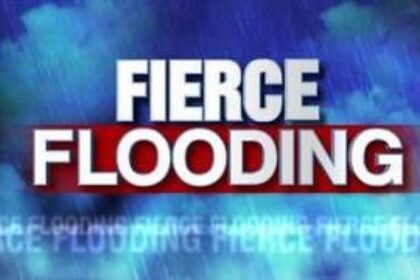
WILKES-BARRE, Pa. – President Barack Obama formally declared an emergency in Pennsylvania early Friday, adding to a previous declaration covering New York state, authorizing federal agencies to coordinate disaster relief efforts in order to “save lives and to protect property and public health and safety,” according to a White House statement.
The remnants of Tropical Storm Lee poured water on top of the already soaked Northeast on Thursday, closing hundreds of roads and forcing evacuation orders for more than 100,000 people from the Susquehanna River’s worst flooding in nearly 40 years.
Most of the evacuations were ordered in and around Wilkes-Barre, where the levee system is just high enough to hold back the river if it crests at the predicted level. Even if the levees hold, 800 to 900 unprotected homes were in danger. If they fail, thousands of buildings could be lost.
“This is a scary situation,” said Stephen Bekanich, Luzerne County’s emergency management director. He and other officials were confident the levees would work but sought volunteers to lay sandbags on both sides of the river.
In Hummelstown, another Pennsylvania community along the river, Donna MacLeod had to be rescued from her home.
“I’m heartsick,” she said. “I know I lost two cars and everything that was in my basement and everything that was on the first floor. But I have my life and I have my dog, so that’s good.”
Upriver in Binghamton, N.Y., a city of about 45,000, the Susquehanna coursed into the streets and climbed halfway up lampposts at a downtown plaza. Mayor Matt Ryan said it was the city’s worst flooding since the flood walls were built in the 1930s and `40s.
Road closures effectively sealed Binghamton off to outside traffic as emergency responders scrambled to evacuate holdouts who didn’t heed warnings to leave. Buses and then boats were used to evacuate residents, and National Guard helicopters were on standby.
“It’s going to get worse,” Gov. Andrew Cuomo said, warning people to leave when they get the order.
Up to nine inches of rain fell in parts of Pennsylvania, and a similar amount fell in Binghamton. Rivers and streams passed or approached flood stage from Maryland to Massachusetts, and experts said more flooding was coming.
The storm compounded the misery for some people still trying to bounce back from Hurricane Irene.
Some of the areas hardest hit by the August storm, such as Vermont, avoided the brunt of the latest bad weather. But in Paterson, N.J., where the Passaic River was rising, about 75 people were still in a shelter because of Irene.
“We just finished cleaning up after the flood from Irene,” said Edith Rodriguez, who lived in shelters for three days and spent Wednesday night at a high school outside Schenectady, N.Y., because of Lee. “Now we have to start all over again.”
Commuters and other travelers searched for detours as highways and other roads were flooded out, including sections of New York’s Interstate 88, which follows the Susquehanna’s path. In eastern Pennsylvania, where hundreds of roads were closed, flooding and a rock slide partially closed the Schuylkill Expressway, a major artery into Philadelphia.
Amtrak passenger service on New York’s east-west corridor was canceled, as were classes at many colleges and schools across the Northeast.
At least nine deaths have been blamed on Lee: four in central Pennsylvania, one in Maryland and four others killed when it came ashore on the Gulf Coast last week.
Pennsylvania Gov. Tom Corbett warned of “a public health emergency because sewage treatment plants are underwater and no longer working.”
“Flood water is toxic and polluted,” he said. “If you don’t have to be in it, keep out.”
Up to 75,000 residents in and around Wilkes-Barre were ordered to leave. The mayor told residents to pack food, clothing and medicine and plan for a three-day evacuation.
The river was projected to crest overnight at 40.8 feet — essentially the same height as the levee system and nearly the level it reached in 1972, when Hurricane Agnes caused massive flooding in the area. Luzerne County officials ordered all communities flooded by Agnes to evacuate for the remnants of Lee.
Rose Simko packed up her car and headed to higher ground to stay with family. She was worried about her house, just 150 feet from a levee, but knew she had to leave.
“Everything is replaceable,” she said, “but my life is not.”
Bekanich said several thousand people left their homes, but he did not yet have a complete total. Shelters prepared to handle close to 5,000 people were beginning to fill up, Luzerne County Commissioner Maryanne Petrilla said.
Some 20,000 evacuations were ordered for the Binghamton area, and another 6,000 to 10,000 in Harrisburg, Pennsylvania’s capital. Crews put sandbags around the governor’s mansion, and the first lady moved furnishings from the first floor as the river spilled over its banks.
At the mouth of the Susquehanna, hundreds of residents of Havre de Grace, Md., also were ordered to leave.
In Port Deposit, Md., about 600 people were urged to evacuate as a dam’s flood gates were opened to cope with the heavy rain. By 4 p.m. the town appeared to be nearly empty, but Roger Kerr, grilling some steaks outside his apartment building, said he planned to ride out the flood.
`’I’ve got stuff to watch. I’m on the second floor, 12 feet high. It isn’t going to get that high,” Kerr said.
It is somewhat unusual to have this many evacuation orders for an American flood, though hurricanes such as Irene can force millions from their homes.
Similar-sized evacuations were ordered in the Northeast for floods in 1996 and 2006 and during the remnants of Hurricane Agnes in 1972. About 11,000 people were evacuated from flood-threatened neighborhoods in Minot, N.D., in July.
Forecasters warned that the dispiriting summer soaking wasn’t over and flooding would last four days or more.
“I really feel sorry for people because the sun will be out next week but the water will still be rising in rivers and streams,” said Mark Wysocki of the Northeast Regional Climate Center at Cornell University.
On Thursday, 98 different USGS river and stream monitors registered flood levels in the Northeast. And there are 26 areas that are considered in major flooding. That’s on top of more than 100 locales that set record flood stages from Hurricane Irene.
Tom Graziano, chief of the Hydrologic Services Division at the National Oceanic Atmospheric Administration, said many streams in the Northeast were showing the highest flows ever recorded for the date.
Irene “really primed the pump” in terms of saturating the ground, Graziano said, “and now we’re adding this tremendous amount of rainfall.”
Though the storm was a remnant of Lee, Wysocki also blamed Hurricane Katia, far out in the Atlantic, for the lingering downpour.
He said Katia and a slow-moving high pressure system over Ohio “acted as blockers,” producing a narrow corridor for the storm as it came north.


